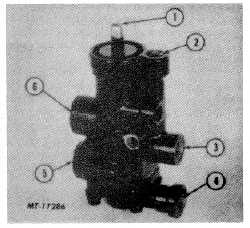SERVICE MANUAL
MIDLAND-ROSS TRACTOR PROTECTION
VALVE
DESCRIPTION
The tractor protection valve (Fig. 1) is normally
mounted at the rear of cab where tractor air system is
connected to the service and emergency air hoses used
for coupling tractor and trailer brake systems. Valve has
a piston arrangement that is pressure sensitive to tractor
air brake system, which provides automatic closing of
both lines when system pressure approaches low energy
levels. Manual actuation of the valve is performed by the
operator through use of a two-way air control valve.
When the control valve is opened (knob pushed in), air
pressure is supplied to control port to open the tractor
protection valve. Pulling air control "out" exhausts the air,
allowing the tractor protection valve to close.
Fig. 1 Tractor Protection Valve
1 Exhaust Port
4 Tractor Service
2 Control Port
5 Trailer Service
3 Tractor Emergency
6 Trailer Emergency
A quick release feature is also incorporated in the
valve and serves to improve normal service brake
release time of trailer brakes. During brake release,
control air delivered to actuate trailer brakes will exhaust
at tractor protection valve as compared to exhausting
through foot or hand control valves.
If either an automatic or manual operation closes the
tractor protection valve, air in the trailer emergency line is
exhausted through the tractor protection valve.
During normal tractor operation without trailer, the air
control valve is "out" and tractor protection valve is
closed. Air passages leading from tractor system to
trailer couplings are blocked.
After coupling a trailer to the tractor, the two-way air
control is pushed "in." Air flows through tractor protection
valve emergency line to charge trailer brake system
reservoirs. Trailer brakes are released simultaneously if
trailer brakes are holding prior to coupling.
During normal tractor-trailer operation, the tractor
protection valve remains open. It allows air to flow in
either direction between trailer air brake system and
tractor air brake system.
Trailer service brakes are applied and released by
driver’s operation of either the foot brake control or hand
control valve. Service brake control air flows through the
service passage of the tractor protection valve. Trailer
air reservoirs and brake system are replenished by air
flow through the emergency passage.
Driver can make an emergency trailer brake
application by moving air control valve "out." Tractor-to-
trailer service and emergency passages close and
exhaust passages open. Trailer brakes apply when air
exhausts from the trailer emergency line through tractor
protection valve exhaust passage.
The air control valve is moved "out" to close tractor
protection valve prior to disconnecting trailer from tractor.
OPERATION
Fig. 2 illustrates the tractor protection valve in the
closed position for operating a tractor without a trailer
(bobtailed). Refer to Fig. 2 for numbers and letters in
parenthesis.
Closed Position (Air Control Valve "Out")
Rubber valve (13) is seated against spool (7) closing
off passage of air through valve from tractor service (F)
to trailer service port (E). Exhaust valve assembly (5) is
seated against valve body (20) closing off passage of air
through valve from tractor emergency (G) to trailer
emergency port (D). The control port kH) and cavity "A"
are vented to exhaust through the two-way air control
valve on instrument panel. Both trailer emergency and
service ports (D and E) are open to atmosphere through
exhaust passages "B and “C”
Open Position (Air Control Valve "In")
When trailer hoses are connected to trailer, air
pressure is supplied from tractor air system to control
port (H) and enters cavity WA. Air pressure above 345
kPa (50 psi) acts against piston (17) to move it towards
spring (19). Piston seats against valve face of assembly
(5). Further movement pushes exhaust valve assem-
CTS-4079 - CHAPTER XI - Page 3


